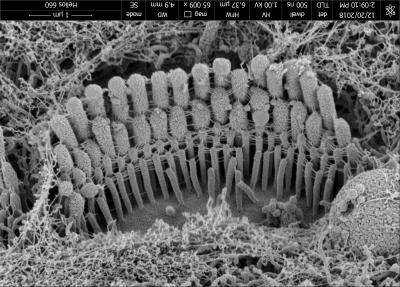Mouse model insight could focus future hearing loss reversal research on early development

Credit: Oregon Health & Science University
New research reveals a key insight into the development of hair bundles, the intricately complex assemblies in the inner ear responsible for hearing.
Hair bundles are precisely arranged cellular structures deep within the spiral cavity of the inner ear. Together, they convert vibrational energy into electrical signals in the brain that translate into the sensation of hearing. Once they’re lost – whether by loud noise, toxins, disease or aging – they do not naturally regenerate in people and other mammals.
The new research led by scientists at Oregon Health & Science University provides important clues that may help scientists develop new techniques to regenerate hair cells and reverse hearing loss.
In the study published in the journal Current Biology, researchers discovered the development of hair bundles occurs in a kind of feedback loop in which form follows function and function drives form.
Using mice, which closely model human hearing, the researchers found stereocilia, roughly 100 of which are assembled into a hair bundle, widened simultaneously with the onset of mechanotransduction – the action of converting mechanical signals in the form of sound into electrical signals measured within the brain. The stereocilia only elongated to their mature lengths after transduction had been established.
It turns out that form and function are mutually reinforcing.
“We’ve been looking at these as separate pathways,” said lead author Jocelyn Krey, Ph.D., staff scientist in the Oregon Hearing Research Center and the Vollum Institute at OHSU. “But in the course of this research, we observed the change in form occurs at the same time as the conversion of mechanical to electrical signals. So we’re seeing these happen together, and feeding each other in a way we hadn’t seen before.”
The researchers discovered when they examined mice lacking transduction or used a compound to block transduction, the animals did not develop the classic staircase-shaped form of mature hair bundles.
Researchers say the study suggests that new techniques to reverse hearing loss should focus on the critical importance of early development.
“In the future, with the rapid development of gene editing tools like CRISPR, we will be able to turn on genes at will,” said senior author Peter Barr-Gillespie, Ph.D., professor in the Oregon Hearing Research Center and senior scientist in the Vollum Institute. “I have no doubt we will be there in 5 or 10 years.”
###
Barr-Gillespie also serves as OHSU’s chief research officer and executive vice president.
The study was supported by confocal microscopy conducted in the OHSU Advanced Light Microscopy Core through National Institutes of Health grant P30 NS061800; electron microscopy performed at the OHSU Multiscale Microscopy Core; and NIH grants R03 DC014544; R01 DC014720; R01 DC002368 and R01 DC011034.
Media Contact
Erik Robinson
[email protected]
503-494-8231
Related Journal Article
http://dx.




